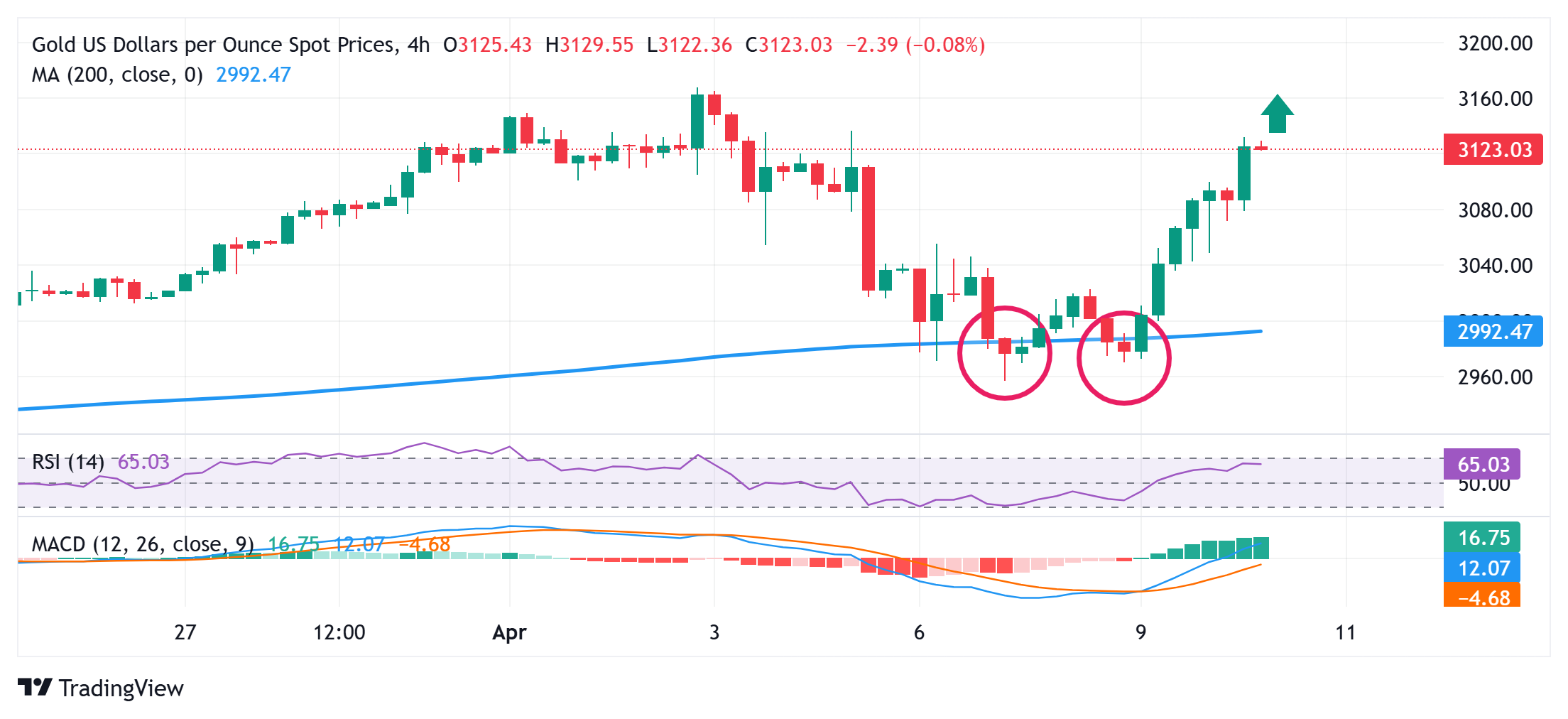- Gold price continues to attract safe-haven flows amid rising US-China trade tensions.
- Bets for multiple Fed rate cuts weigh on the USD and also benefit the precious metal.
- A solid recovery in the risk sentiment fails to undermine the safe-haven XAU/USD pair.
Gold price (XAU/USD) touches a fresh weekly top, around the $3,132-3,133 area heading into the European session as concerns about escalating US-China trade tensions continue to drive safe-haven flows. Moreover, fears that tariffs would hinder economic growth and boost inflation turn out to be another factor that benefits the precious metal’s status as a hedge against rising prices. Apart from this, bets for multiple interest rate cuts by the Federal Reserve (Fed) push the non-yielding higher for the second successive day.
Meanwhile, the prospects for further easing by the Fed fail to assist the US Dollar (USD) to attract any meaningful buyers, which lends additional support to the Gold price. The positive momentum seems rather unaffected by a sharp recovery in the global risk sentiment, bolstered by the optimism over US President Donald Trump’s decision to pause reciprocal tariffs on most nations. Traders now look to the US consumer inflation figures for cues about the Fed’s rate-cut path, which should provide some impetus to the XAU/USD pair.
Daily Digest Market Movers: Gold price bulls retain control as US-China trade war continues to boost safe-haven demand
- In less than 24 hours after steep new tariffs kicked in on Wednesday, US President Donald Trump abruptly took a U-turn and announced a 90-day pause on hefty duties on most nations for 90 days. Trump, however, jacked up the tax rate on goods from China to 125% after the latter declared that it is putting an additional 50% tariff on US imports.
- Investors now seem worried that an all-out trade war between the world’s two largest economies would stoke inflation and
- hinder global growth. This, in turn, assisted the safe-haven Gold price to rise more than 2% on Wednesday and post its best day since October 2023. The momentum seems unaffected by a sharp recovery in equity markets.
- Traders slashed their bets for more aggressive rate cuts by the Federal Reserve (Fed) after March FOMC meeting minutes revealed that officials unanimously agreed that the US economy was at risk of experiencing higher inflation. Adding to this, a slew of influential Fed policymakers called for a cautious approach to interest rate cuts.
- Minneapolis Fed President Neel Kashkari said that the bar for cutting rates remains high as tariffs can lead to inflation. Adding to this, Cleveland Fed President Beth Hammack noted that monetary policy is modestly restrictive right now, though he would prefer to wait than move in the wrong direction with interest rates.
- Separately, Richmond Fed President Tom Barkin warned that tariff price hikes could begin by June and price surges require the US central bank to be cautious. Furthermore, St. Louis Fed President Alberto Musalem said that it is risky to assume the Fed can look through higher prices from tariffs, there is a chance some effects could persist.
- Traders were quick to react and are now pricing in the possibility that the Fed will resume its rate-cutting cycle in June and deliver just 75 basis points of rate reductions over the course of the year. This, however, does little to assist the US Dollar to capitalize on the overnight bounce or attract any sellers around the non-yielding yellow metal.
- Investors now look forward to the release of the US consumer inflation figures, which will be followed by the US Producer Price Index (PPI) on Friday, for fresh cues about the Fed’s rate-cut path. This, in turn, will play a key role in influencing the near-term USD price dynamics and providing a fresh directional impetus to the XAU/USD pair.
Gold price seems poised to appreciate further and retest record high, around $3,167-3,168 touched last week

From a technical perspective, the commodity showed some resilience below the 200-period Simple Moving Average (SMA) earlier this week and the subsequent move higher favors bullish traders. Moreover, positive oscillators on the daily chart support prospects for a further appreciating move for the Gold price. Hence, some follow-through strength towards retesting the all-time peak, around the $3,167-3,168 region touched earlier this month, looks like a distinct possibility.
On the flip side, weakness back below the $3,100 mark might now find decent support near the $3,065-3,060 region. The said area should act as a key pivotal point, which if broken decisively could make the Gold price vulnerable to accelerate the fall back towards the $3,000 psychological mark. The latter now coincides with the 200-period SMA on the 4-hour chart, which should act as a key pivotal point and if broken decisively, might shift the near-term bias in favor of bearish traders.
Economic Indicator
Consumer Price Index (YoY)
Inflationary or deflationary tendencies are measured by periodically summing the prices of a basket of representative goods and services and presenting the data as The Consumer Price Index (CPI). CPI data is compiled on a monthly basis and released by the US Department of Labor Statistics. The YoY reading compares the prices of goods in the reference month to the same month a year earlier.The CPI is a key indicator to measure inflation and changes in purchasing trends. Generally speaking, a high reading is seen as bullish for the US Dollar (USD), while a low reading is seen as bearish.
Read more.

